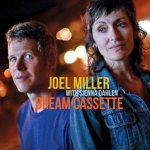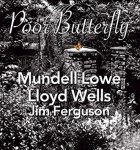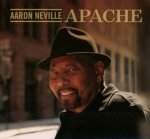PICK OF THE MONTH
 Joi
Joi
Joi Sound System (compilation; 2 discs)
Real World
CDRWG208
I usually keep a close eye on the Real World label’s release list, but this one somehow escaped my notice last year. Joi formed in 1983 as a DJ duo consisting of Anglo-Bangladeshi brothers Farook and Haroon Shamsher; since Haroon’s death in 1999, Farook has continued to work under the Joi moniker. After a decade of spinning records and promoting Bangladeshi cultural events in England, they began recording original music that acted as a continuation of their English-Bangladeshi fusion project, blending traditional Bengali sounds with Western beats and production approaches, incorporating elements of hip hop, jungle, and electronica, becoming foundational members of the burgeoning Asian Underground movement. One thing that’s interesting about this two-disc retrospective is the fact that although its component tracks were recorded between 1991 and 2006, you don’t hear anything that can reasonably be called progression or growth in their music–their ideas seem to have been well formed from the beginning, and while there is a fairly wide variety of styles in evidence, that variety seems to have been a function of their approach at all times. This is consistently, deeply enjoyable music from start to finish, and as a historical document this collection offers both a good overview of the band and a great introduction to the Asian Underground movement generally. Highly recommended to all libraries. (For an overview of the Real World label’s highly diverse stable of artists and long history of stylistically globe-trotting releases, libraries should also consider picking up Real World 25, a three-disc compilation featuring artists as varied as Daby Touré, Sheila Chandra, Nusrat Fateh Ali Khan, Värttinä, and of course label founder Peter Gabriel.)
CLASSICAL
 Thomas Adès; Per Nørgård; Hans Abrahamsen
Thomas Adès; Per Nørgård; Hans Abrahamsen
Danish String Quartet
ECM
2453
This is a program of works by very young composers played by an ensemble of very young musicians. To be clear, not all of the composers are very young today, but all were in their 20s when they wrote these pieces, and each of these three string quartets represents the first work in that format by each composer. Nevertheless, the three works span the second half of the 20th century: Per Nørgård’s Quartetto Breve was written in 1952; Hans Abrahamsen’s 10 Preludes in 1973; Thomas Adès’ Arcadiana in 1994. Stylistically there is not much to unite them: the Nørgård quartet is more influenced by Bartók, the Abrahamsen piece points to 1960s minimalism without entirely embracing it, and the Adès work sounds like neither. But the Danish String Quartet imbues all of these works with a shimmering intensity and bravura virtuosity.
 Carl Philipp Emanuel Bach
Carl Philipp Emanuel Bach
Cello Concertos
Nicolas Altstaedt; Arcangelo / Jonathan Cohen
Hyperion (dist. Harmonia Mundi)
CDA68112
Of all of J.S. Bach’s many musical sons, C.P.E. remains the most popular and well-known, partly because he was so prolific and partly, I think, because his music offers such a lovely window into the transitional period between the baroque and classical periods. His concertos do this particularly effectively, and the cellos concertos are especially interesting because it’s still not clear whether they were originally written for the cello or the harpsichord. Cellist Nicolas Altsteadt is a brilliant young musician whose name we will be hearing with increasing frequency in coming years; here he provides a marvelous period-instrument account of these important works. Recommended to all classical collections.
 Luigi Rinaldo Legnani
Luigi Rinaldo Legnani
Complete Music for Flute and Guitar
Arius Duo
Brilliant Classics (dist. Naxos)
95141
This is the first I’ve heard of Luigi Rinaldo Legnani, a 19th-century singer, guitarist, and composer who was — chant it along with me, now — well-known and highly regarded in his time but is largely forgotten today. His most well-known works are for solo guitar, but this lovely collection of duets shows him to have been a gifted composer of thoroughly enjoyable, if arguably slight, works for small chamber ensemble. Not unexpectedly, the guitar parts are especially impressive, but all of it is a delight. (The Arius Duo play on modern instruments.)
 Antonin Reicha
Antonin Reicha
Complete Chamber Music for Clarinet (2 discs)
Luigi & Laura Magistrelli; Cristina Romanò; Italian Classical Consort
Leonardo/Urania Arts (dist. Naxos)
LDV 14025
Rick’s Pick
I freely admit to being a clarinet junkie, and chamber music for clarinet written in the late classical and early Romantic periods have a particular hold on me. So I was quite excited to see the release of this album, especially given that it includes world-premiere recordings of the opus 107 quintet and of the Grand Duo Concertant for Two Clarinets and Strings. That fact alone makes it a strong candidate for library acquisition, but the beautiful, lilting performances by the featured clarinetists and the Italian Classical Consort (on modern instruments) are what make this set such a pure joy.
 Various Composers
Various Composers
Tranceclassical
Maya Beiser
Innova (dist. Naxos)
Rick’s Pick
Seeing the word “trance” embedded in the title of this disc by cellist Maya Beiser, one might be tempted to dismiss it as crossover, mood-music fluff. I recommend that you not make that mistake. Yes, Beiser is a little bit of a renegade, and yes, this program does include arrangements of music by Lou Reed and Imogen Heap, but as Beiser explains, this album represents “the arc my mind sketches between everything I create and Bach” (whose music opens the program). Tracing that arc as you listen to the album is part of its fun, and listening to how creatively she interprets everything she touches is another part of it. Highly recommended to all libraries.
 Devin Maxwell
Devin Maxwell
Works 2011-14
Various performers
Infrequent Seams (dist. Redeye)
8
Whenever I find out that a drummer is a gifted composer, I have two immediate reactions in quick sequence: first I’m surprised; then I feel terribly guilty for being surprised. Anyway, this collection of acoustic and electronic compositions by drummer (and composer!) Devin Maxwell gave me yet another opportunity to berate myself for my reflexive string-player bigotry: here we have an excellent program of works for fixed-media electronics, string quartet, orchestra with electronics, and various configurations of chamber ensemble. All are challenging, some — the string quartet piece in particular — are downright abrasive, but all are rewarding, from the pointillistic Bunt Do Gone (for saxophone, piano, and electronics) to the dense, almost Varèse-like Chester, NJ (for orchestra and fixed-media electronics). Recommended to all libraries with a collecting interest in new and avant-garde music.
 Pierre de la Rue
Pierre de la Rue
Missa Nunqua fue pena mayor; Missa Inviolata
Brabant Ensemble / Stephen Rice
Hyperion (dist. Harmonia Mundi)
CDA68150
Rick’s Pick
A new album of de la Rue Masses is cause for celebration, and in my view, a new album of de la Rue Masses performed by the Brabant Ensemble is cause for a national holiday. Along with groups like Stile Antico and Alamire, the Brabants are the class of the current Oxbridge school of choral singing, and they never sound better than when they’re working with the Franco-Flemish masters. As always, the creamy sweetness of their vocal blend is a perfect setting for these masterworks of 15th-century liturgical choral music, and this album (like everything else the Brabants have released) is a must-own for classical library collections.
 Various Composers
Various Composers
Music for Brass Septet 4
Septura
Naxos
8.773526
This is the fourth volume in an ongoing series in which the brass septet Septura takes works from a variety of musical periods and either creates or commissions new arrangements of those works for their own unique instrumentation. Previous volumes in the series have featured pieces by Handel, Shostakovich, Mendelssohn, Rachmaninov, Purcell, and others, but here the focus is on choral composers of the counter-reformation period: Giovanni Gabrieli, Tomás Luis de Victoria, Giovanni Palestrina, and Orlando de Lassus. Motets, lamentations, Mass sections, and canzonas are all given the brass treatment and they are all exceptionally beautiful. Libraries supporting brass programs and transcription or orchestration courses should definitely pick this one up, as well as the other three volumes in the series.
 Lubomir Melnyk
Lubomir Melnyk
Illirion
Sony Classical
88985315582
They’re calling Lubomir Melnyk the “Prophet of the Piano,” and based on the cover photo of his first album for the Sony label, he doesn’t seem to mind. (If I were being called something like that, you can bet that the last thing I’d let anyone do is take a picture of me wearing a coarse robe, long hair, and a beard.) Reportedly, the reason they call him the “Prophet of the Piano” is his lifelong devotion to the instrument — but it could also be because of the mystical nature of his music, which is harmonically minimalist but densely written, featuring cascading layers of repeated patterns that change steadily without ever creating a sense of strong forward movement. Inevitably, concertgoers report going into a trance while listening. Melnyk’s pianistic technique is quite astounding, and although the music itself isn’t really my thing, it might well be yours — and, more importantly, your patrons’.
JAZZ
 Michika Fukumori
Michika Fukumori
Quality Time
Summit
DCD 679
Pianist Michika Fukumori swings powerfully but with deceptive gentleness on this, her second album as a leader. The program consists mostly of standards, plus four originals, and her bassist and drummer give her plenty of space to stretch out, which she does decorously but with incisive intelligence. For me, the highlight is her heartbreaking rendition of “Somewhere,” from West Side Story, but there’s really not a weak track on this album. This is straight-ahead, old-school piano jazz at its best.
 Joel Miller with Sienna Dahlen
Joel Miller with Sienna Dahlen
Dream Cassette
Origin
82713
Rick’s Pick
This is a delightfully strange album from saxophonist/composer Joel Miller, one that will surely get filed in the Jazz section even though it won’t sound anything like 99% of what you’ll find there. on Dream Cassette he is collaborating with singer and lyricist Sienna Dahlen, and drawing on the relatively simple (sometimes nearly pentatonic) traditions of American folk music–but none of his compositions sound folky, and they only rarely sound jazzy. Dahlen’s voice is often central to the arrangements, but it’s not usually the most sonically prominent element. I’m running out of ways to describe this album by saying what it isn’t. Just give it a listen. It’s gorgeous.
 Michael Gamble and the Rhythm Serenaders
Michael Gamble and the Rhythm Serenaders
Michael Gamble and the Rhythm Serenaders
Organic
OR 16552
At the exact opposite end of the jazz-experimentation spectrum is this delightful collection of early swing and traditional jazz numbers organized by the Asheville, NC-based Michael Gamble. Gamble runs the annual Lindy Focus festival in that town, a five-day event that features both big band performances and dance instruction. During a recent festival, Gamble took advantage of the presence of so many fine swing musicians and put together this recording, which consists of faithful reproductions of vintage jazz sounds recorded live in the studio. Vocal numbers like “He Ain’t Got Rhythm” and “Fine and Mellow” rub shoulders with instrumentals by the likes of Duke Ellington and Benny Goodman, and all of it is tons of fun.
 Sara Gazarek and Josh Nelson
Sara Gazarek and Josh Nelson
Dream in the Blue
Steel Bird
No cat. no.
Pianist Josh Nelson and singer Sara Gazarek have worked together for years, but this is the first album to document an increasingly central aspect of their collaboration: their work in a straight voice-piano duo format. It features classic bossa nova, adaptations of songs by Nick Drake and Bonnie Raitt, standards like “On the Sunny Side of the Street” and “Mood Indigo,” and more, all arranged in a highly personal style that reflects the pair’s deep musical connection without ever coming across as self-indulgent. Very, very nice.
 Mundell Lowe; Lloyd Wells; Jim Ferguson
Mundell Lowe; Lloyd Wells; Jim Ferguson
Poor Butterfly
Two Helpins’ o’ Collards
THOC-001
Mundell Lowe has been a legend of jazz guitar for pretty much the last 70 (that’s not a typo: seventy) years, having recorded alongside the likes of Charlie Parker(!), Carmen McRae, and Billie Holiday, as well as playing regularly with the André Previn Trio and scoring films and TV shows in the 1970s. Now 93, he still plays sweetly and inventively, and on this soft-edged album he leads a two-guitars-plus-bass trio through a very fine program of standards including the title track, “My Shining Hour,” and “Here’s That Rainy Day.” This is excellent straight-ahead jazz in an unusual format.
 Behn Gillece
Behn Gillece
Dare to Be
Posi-Tone
PR8158
Rick’s Pick
This is vibraphonist Behn Gillece’s debut album as a leader, and it’s outstanding. From the outset, one of the first things you’ll notice is how hard he swings: “Camera Eyes” and “From Your Perspective” are both midtempo powerhouses of rhythmic propulsion, and what’s impressive is that he maintains that momentum regardless of tempo. What are also impressive are his writing chops and his prowess as an arranger: leading a quintet that also includes guitar, bass, drums, and trumpet, he makes every setting feel rich and full despite the lack of a piano. Great stuff.
FOLK/COUNTRY
 The Coal Men
The Coal Men
Pushed to the Side
Vaskaleedez
No cat. no.
Rick’s Pick
I confess that I was expecting something more along the lines of rockabilly or a roots-rock power trio sound from this album. I was definitely not expecting what I heard: richly atmospheric neo-country-rock that fills a maximum amount of sonic space with a minimum of instruments and sonic frills, and that takes quiet emotion and turns it into hooks. Imagine American Music Club with a less ironic take on honky-tonk tradition, or a (much) less pretentious Cowboy Junkies. Bandleader Dave Coleman (get it?) has a fantastic, chesty baritone voice and admirable guitar chops, but the arrangements and the production are almost as big a part of this album’s success as the songs are. When’s the last time you heard someone say that about a country album? This one’s a must-have.
 Various Artists
Various Artists
On Top of Old Smoky: New Old-time Smoky Mountain Music
Great Smoky Mountains Association
No cat. no.
Most of these songs were originally collected by Joseph Hall during his research in the Smoky Mountain region in the 1930s and 1950s. Some have since become familiar (“I Wonder How the Old Folks Are at Home,” “Will the Circle Be Unbroken,” “On Top of Old Smoky”) while others have remained obscure. The same is true of the lineup of musicians on this album, which includes not only Dolly Parton, Alice Gerrard, and Tony Trischka, but also lots of equally fine folkies with whom many listeners will not be familiar. (Notable among them is the duo of Jody Stecher and Kate Brislin, who are well known on the circuit but deserve much wider recognition.) This album should definitely be of interest to libraries with a collecting interest in regional American music.
 Dietrich Strause
Dietrich Strause
How Cruel That Hunger Binds
Self-released
No cat. no.
When he’s not playing scorching guitar and singing pristine harmony vocals with breakout retro-soul-pop band Lake Street Dive, Dietrich Strause makes solo albums in a slightly quirky Americana-folk-soul-rock mode. His third effort finds him continuing to develop a blend — really a patchwork rather than a fusion — of American popular song traditions old and new, layering country and folk inflections over old-school soul beats and traditional-sounding original melodies. His sweet tenor voice — which puts me in mind, oddly enough, of Josh Caterer — is often wrapped in reverb to make it sound farther away, which lends a bittersweet tinge to the already moody (but tuneful) songs. Recommended to all collections.
ROCK/POP
 Pitch Black
Pitch Black
Filtered Senses
Dubmission
CDDUBM063
It’s been too long — seven years — since the last release by Pitch Black, the New Zealand-based duo of Paddy Free and Mike Hodgson. Since then, their personal brand of warm and atmospheric downtempo electronica, with regular incursions of both thumping techno beats and gently bubbling dubwise reggae elements, has only become more necessary in a world that has been steadily going murderously insane. Most of this music will be strikingly ineffective at luring anyone out onto the dance floor — the first really propulsive track is also the last one on the album. But if you need help getting your pulse rate down, and if you need a little bit of instrumental reassurance that the universe is a gentle and orderly place, this album is a great place to start.
 Aaron Neville
Aaron Neville
Apache
Tell It Productions
TELIT001CD
Aaron Neville may be New Orleans’ most celebrated living musical son, famous for the featherweight falsetto voice that contrasts so sweetly with his prison tattoos and his ex-con bulk. In terms of style, he’s never completely left the 1950s behind, although there’s an argument to be made that his singing owes as much to New York doo-wop as it does to New Orleans soul and R&B. At 75 years of age, he has made his toughest and funkiest album in years, one that pays homage to his roots and showcases a voice that still has the capacity to soothe and to thrill — and he has writing credits on all but one of these eleven songs. Did I mention that he’s 75 years old?
 Wilson Pickett
Wilson Pickett
Land of 1000 Dances: The Complete Atlantic Singles Vol. 1
Real Gone Music
RGM-0487
A Wilson Pickett retrospective isn’t really news, but this is the first entry in what will eventually be a three-volume collection of all Pickett’s single releases for the Atlantic label, all in their original monophonic versions — and that is news. It means definitive accounts of world-changing hits like “Mustang Sally,” “Funky Broadway,” and (of course) “In the Midnight Hour.” Excellent sound and good liner notes with track-by-track commentary make this compilation not only a powerful listening experience but also a valuable library resource. Recommended to all collections.
 Bérangère Maximin
Bérangère Maximin
Dangerous Orbits
Crammed Disques
300749
Bérangère Maximin is one of those composers that generally get referred to as “sound sculptors,” because the music they create doesn’t follow the usual rules of musical composition: no harmonic movement, little if anything in the way of rhythmic pulse, nothing that could reasonably be called melody. But that doesn’t mean there’s no structure, it doesn’t mean the music isn’t interesting, and it certainly doesn’t mean it’s noise. This is an album that could really have gone into either the Classical or the Rock/Pop section, which tells you something. I find it wonderful; small children might be a little creeped out, though — the mood is consistently dark and foreboding.
 Josh Ritter
Josh Ritter
Sermon on the Rocks
Pytheas
CD-PYTH-008
As its title might lead you to believe, the latest album from roots-rock singer-songwriter Josh Ritter has God (or at least religion) on the mind: there’s hardly a song here that doesn’t mention the Bible, heaven/hell, good/evil, paradise, or faith. The title also hints at Ritter’s love of words, which often come a mile a minute on the uptempo numbers. Where that might be annoying with a less accomplished songwriter, here the flood of verbiage is a pleasure, and it sets the more minimalist songs in brighter, sharper relief. The playing is solid, meat-and-potatoes singer-songwriter roots rock. Recommended.
 B-52’s
B-52’s
Live! 8.24.1979
Real Gone Music
RGM-0485
When this live album was recorded, the B-52’s had been a band for only a couple of years and had just barely hit the big time. They were opening for Talking Heads at the Berklee Center in Boston, a much larger and more luxurious venue than they were used to, and you can hear some of their nervousness in the set — which is not a criticism. What that nervousness does is accentuate the fundamental paradox at the heart of the B-52’s music: a heady, volatile blend of fear, menace, and kitschy fun. Fred Schneider doesn’t sing; he warns, he wails, he shrieks, he declaims. Try to imagine him smiling while you listen to him — it’s impossible. Behind him, Kate Pierson and Cindy Wilson warble like space-age sirens and deliver ominous squiggles of Farfisa organ that sound like 1930s horror-movie soundtracks, while Ricky Wilson plays demented surf licks on a weirdly-tuned four-string guitar. “Rock Lobster” and “Private Idaho” may be regarded as goofy party anthems today, but listen more carefully: what the B-52’s were doing was punk rock of a completely unique character. And you definitely hear that best in a live setting.
WORLD/ETHNIC
 Slavic Soul Party!
Slavic Soul Party!
Slavic Soul Party! Plays Duke Ellington’s Far East Suite
Ropeadope
RAD-314
I know that Balkan brass band music is all the rage these days, but I’ve never been able to get into it for some reason. But I was intrigued enough by this concept — a Balkan-style band performing a major large-scale Duke Ellington composition — that I gave it a listen, and I’m glad I did. The music is a hoot and the band’s energy is irresistible, but for libraries this recording also provides an impressive (and fun) example of intercultural stylistic fusion. Professors will want to play sections of this album back to back with recordings of Ellington’s orchestra playing the same pieces and discuss both how flexible Ellington’s themes are and how strongly they continue to come through regardless of how they’re interpreted.
 John Brown’s Body
John Brown’s Body
Fireflies
Easy Star
ES-1056
A couple of weeks ago I suddenly said to myself, “Man, I wonder when we’re going to get another John Brown’s Body album? It’s been too long.” As if in answer to prayer, Fireflies showed up in my mailbox just a few days later. And it confirms what we’ve always known: John Brown’s Body is the best reggae band in America. Whether bubbling in a dancehall style or building their own trademarked dense, swirling postmodern reggae grooves, JBB makes music that positively demands to be put on repeat. Elliot Martin’s voice soars above the mix like an eagle, and the horns provide a solid sonic core for everything else. There aren’t any hair-raising standout tracks (like, for example, “What We Gonna Do?” from Pressure Points), but every song is rock-solid — and, again, better than anything being produced by any other American reggae band right now.
 Tippa Lee
Tippa Lee
Cultural Ambassador (2 discs)
Stones Throw
721832
Longstanding reggae fans may have a faint memory of Tippa Lee, whose last hit was an anti-police-harrassment anthem back in 1988. Lee’s subsequent relocation to Los Angeles positioned him to be coaxed back into the studio by producer and Dub Club impresario Tom Chasteen, and the result is this very fine album, a surprisingly fresh-sounding throwback to the heyday of singjay-style conscious dancehall reggae. Apart from the tired metareggae of “Tribute to Bob Marley,” this album is all killer and no filler, and those who buy it in CD format get an outstanding bonus in the form of a second disc’s worth of dub versions. Recommended to all libraries with a collecting interest in reggae music.
 HIRIE
HIRIE
Wandering Soul
Rootfire Cooperative
No cat. no.
There’s nothing wrong with some good pop reggae, and currently no one is purveying that genre more winningly than singer-songwriter Patricia Jetton, who records under the slightly awkward moniker HIRIE. On her sophomore album she continues in a smooth modern-roots mode, but don’t let the shiny surfaces of her sound fool you: she’s unapologetic about her smoking (“Don’t Take My Ganja,” “Boom Fire”), willing to confront the pervasive sexism of the reggae scene (“Woman Comes First”), and uninterested in being told how to live her life (“Almost Home”). And her voice is a thing of wonder. This is one of the year’s finest reggae albums.
 Jean-Guihen Queyras
Jean-Guihen Queyras
Thrace: Sunday Morning Sessions
Harmonia Mundi
HMC 902242
Rick’s Pick
On the surface, this disc looks like the product of a familiar formula: take a celebrated classical musician playing a traditional Western European instrument (the cello is always a good choice), put him or her in a studio with the players of “exotic” ethnic instruments from a musical culture that makes extensive use of modal melody, and bang, you have it: an intercultural fusion album that you can sell to self-consciously urbane NPR listeners. That may be what this album looks like at first blush, but it’s not what it is. Cellist Jean-Guihen Queyras and percussionists Bijan and Keyvan Chaemirani grew up together in Provence, and they are joined here by Greek politiki lyra player Sokratis Sinopoulos for a shared musical exploration of the music of Thrace — which is, appropriately enough, the geographical gateway between Western Eruope and the Levant. Some of these tunes are traditional, others are modern compositions in an ancient style; one is a cello solo by Lutoslawski. There are dance tunes and laments, improvisations and a highly technical étude. All of it fits together, though strangely so. None of it is Starbucks-style “world fusion” music. Strongly recommended to all collections.
 Richard Bona & Mandekan Cubano
Richard Bona & Mandekan Cubano
Heritage
Qwest
23425
Rick’s Pick
The music of Cuba has been shaped significantly both by traditions brought to the island by African slaves and by the European culture of the Spanish slaveholders, and those two disparate strands of tradition have created an unusual musical emulsion on that small island. Bassist and singer Richard Bono has long delighted in exploring Cuban music in all of its kaleidoscopic variety, turning it from side to side in order to expose its different facets: West African call-and-response here, complex son cubano rhythms there, lots of massed horns and percussion throughout. On Heritage he does it again, this time in the company of the outstanding Mandekan Cubano ensemble. As always, his smooth and sweet voice is centrally important to the project, but the band sounds fantastic too. This is a tremendously enjoyable album.